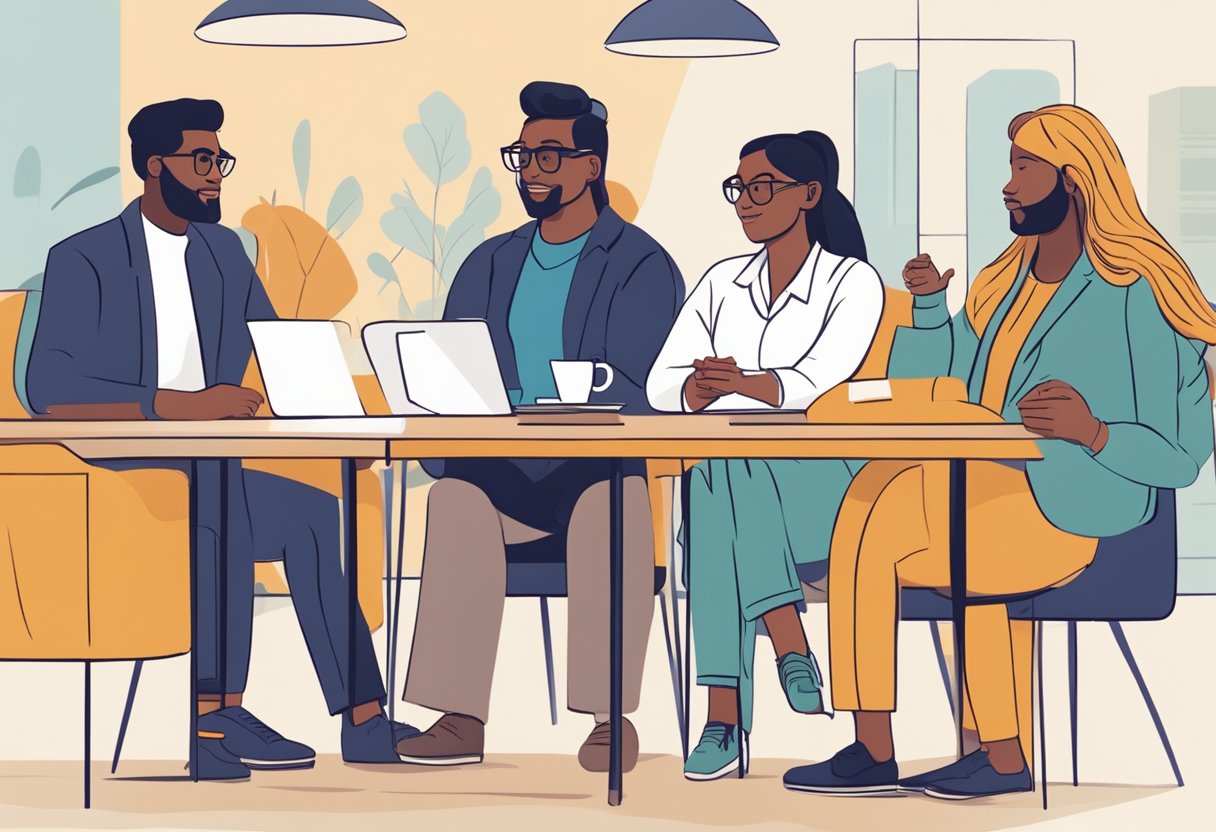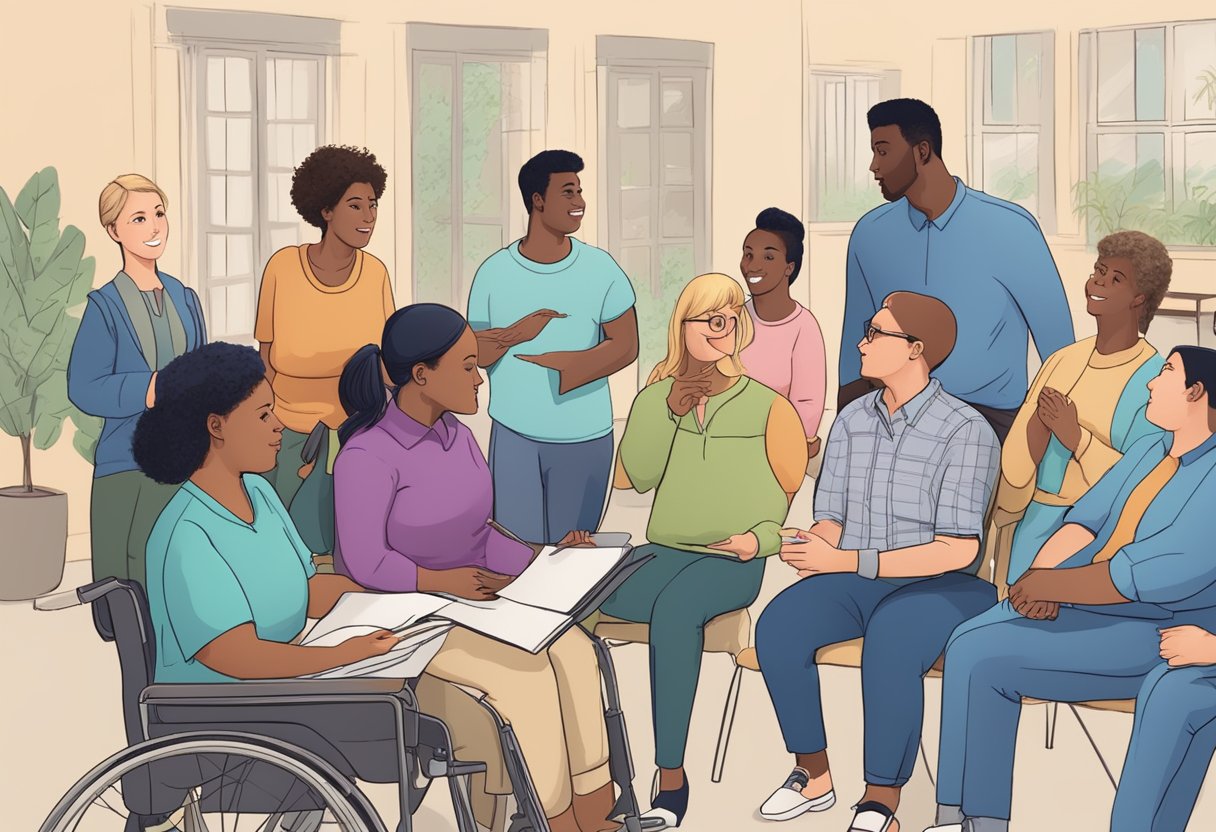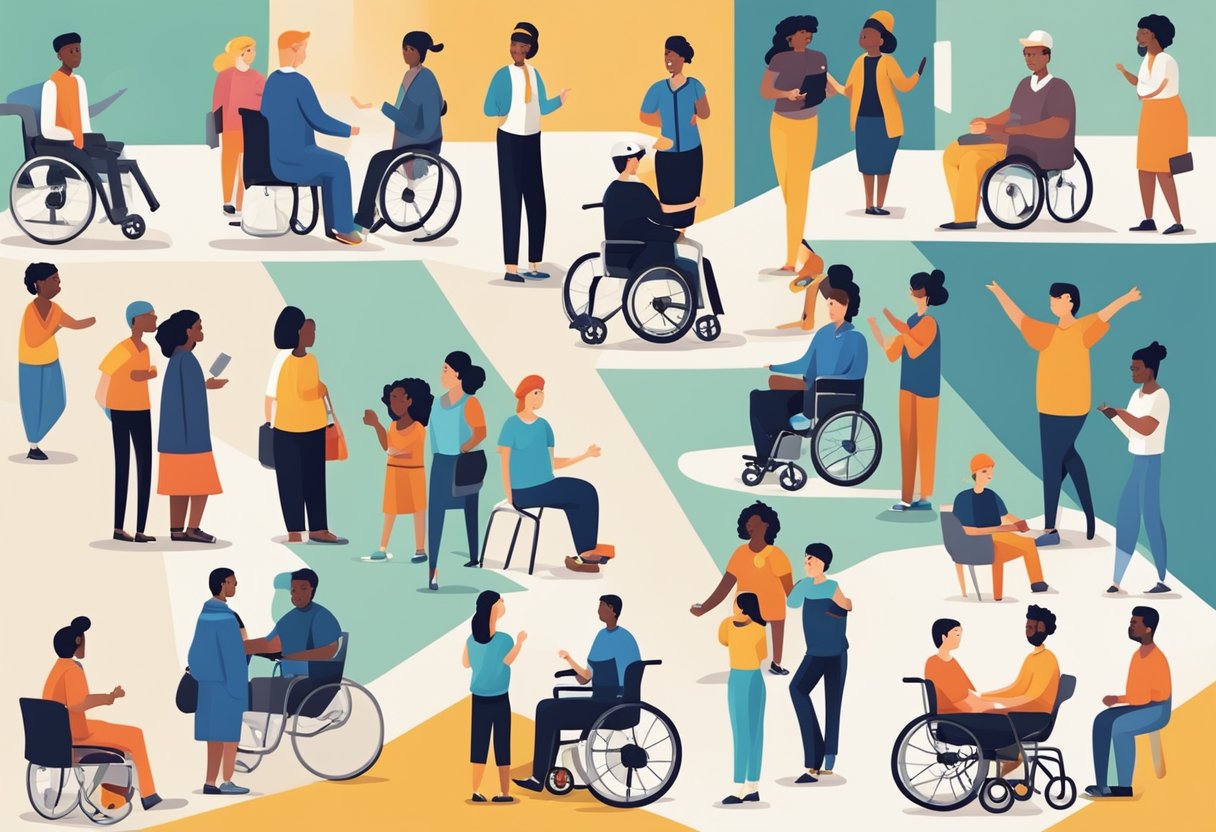Understanding Disability
This section explores the concepts behind the term “disability,” including the evolution of its definition, terminology, and the development of a collective history and identity.
Definition and Terminology
Disability is a term that encompasses impairments, activity limitations, and participation restrictions. It highlights the interaction between an individual’s health condition and the contextual factors: social and environmental. Terminology in this realm is pivotal; words such as “person with a disability” and “disabled person” are used to convey respect and personhood, though preferences can vary among individuals.
“The International Classification of Functioning, Disability and Health (ICF) offers a modern understanding, framing disability as an umbrella term for impairments, activity limitations, and participation restrictions.” In this framework, disabilities are seen not solely as characteristics of the person but as a result of the interaction between the person and social factors, including barriers to access and ableism. Lawrence Carter-Long, a disability rights activist and communicator, emphasizes that the language used to discuss disability should reflect the individual’s identity and agency.
Disability History and Identity
Disability history traces the changes in the perception and treatment of disabled individuals over time. Before legislation such as the Americans with Disabilities Act (ADA), people with disabilities faced significant barriers in society. However, the adoption of the ADA marked a turning point, legally affirming the rights of people with disabilities.
Through the years, a collective identity among those with disabilities has emerged, fostering a sense of community and solidarity. This identity counters ableism and advances equality, highlighting how societal structures and attitudes, rather than the disability itself, often impose limitations on disabled individuals. It is a movement built on the acknowledgment of rights and the push for societal integration and accessibility.
Inclusive Language
Inclusive language in the context of special needs or disability is essential for respect and empowerment. It involves the choice between person-first and identity-first language and requires avoiding derogatory terms often disguised as euphemisms.
Person-First vs. Identity-First
Person-first language puts the individual before the disability, highlighting that the person is not defined solely by their disability. An example of person-first language is saying “person with a disability” instead of “disabled person.”
In contrast, identity-first language acknowledges that disability plays a significant role in the person’s identity. Some individuals prefer identity-first language, such as “autistic person” because they believe it accurately reflects their experience of being inseparable from their autism.
Word choice and use of respectful language matters as many phrases used historically such as Mental Retardation are no longer acceptable and are considered a derogatory term and an example of an offensive term.
Avoiding Offensive & Ineffective Euphemism
Euphemisms for disability can often be offensive, even when unintentionally so. Terms that seem harmless can belittle and patronize; thus, they should be avoided. For instance, “differently-abled” or “special” can be perceived as condescending. Instead, one should use the terms that individuals prefer and that the broader community of people with disabilities has accepted as respectful.
Legal Framework and Rights

The legal landscape in the United States includes comprehensive legislation designed to protect the rights and dignity of individuals with variations in ability. This legal framework ensures equitable access and seeks to eliminate discrimination in various spheres of public life.
The Americans with Disabilities Act
The Americans with Disabilities Act (ADA) represents a broad civil rights law prohibiting discrimination against individuals with disabilities in all areas of public life. Enacted in 1990, the ADA covers various sectors, including employment, education, transportation, and public accommodations. Under the ADA, entities are required to provide reasonable accommodations to individuals, ensuring they have the same opportunities as those without disabilities. The scope of the ADA is wide, and its impact is substantive, as it enables participation and access that might otherwise be denied.
Individuals with Disabilities Education Act
The Individuals with Disabilities Education Act (IDEA) mandates that children with disabilities are entitled to a free appropriate public education (FAPE) tailored to their individual needs. IDEA emphasizes special education and related services, which should be designed to meet the unique learning requirements of students with disabilities, thus preparing them for further education, employment, and independent living. This act has played a pivotal role in transforming educational opportunities for students with disabilities, ensuring that educational institutions facilitate the necessary support and services for their inclusion.
Section 504 and Accommodations
Section 504 of the Rehabilitation Act of 1973 is a civil rights statute that prohibits discrimination based on disability in programs and activities that receive federal financial assistance. A crucial component of this statute is the requirement for schools to provide accommodations and modifications to disabled students, thereby allowing them full participation in schools and classrooms. These accommodations might include alterations to the environment, curriculum format, or teaching methodology to address the specific needs of the student without fundamentally altering the nature of the service, program, or activity.
Communication Approaches

The language used when addressing individuals with disabilities and their families is crucial. It should reflect respect, dignity, and the individuality of each person.
Addressing Individuals with Disabilities
When speaking with or about individuals with disabilities, it is important to use person-first language, which acknowledges the person before their disability. Wrong words or terms like “person with a disability” are preferable because they emphasize the individual’s humanity. For adults with disabilities, this approach conveys recognition of their autonomy and personhood. For children, it is equally important as it places the child first, not their disability, fostering an environment where they are seen for their potential and abilities.
In educational and professional settings, disability advocates recommend avoiding phrases that define individuals primarily by their disabilities. For instance, rather than saying “disabled people,” one should say people with disabilities. This small shift in language can make a significant difference in how individuals perceive themselves and are perceived by others.
Interacting with Parents and Families
Parents or families of children with disabilities often face diverse challenges and experiences. When communicating with them, professionals and educators should adopt a respectful and supportive tone, recognizing the unique experiences of each family. Parents of children with disabilities should be referred to with language that expresses partnership and collaboration.
Open dialogue is important; ask parents how they prefer to discuss their child’s abilities and needs. By doing so, it respects their knowledge of their child and their preferences for the language used. Here, specificity matters – for example, discussing “support for your child’s communication skills” rather than using vague terms like “help with special needs.”
| Do Say | Don’t Say |
|---|---|
| Child with autism | Autistic child |
| Accessible parking | Handicapped parking |
| Uses a wheelchair | Confined to a wheelchair |
In all communications, the aim must be to affirm the individual’s worth and to ensure language supports that ethos.
Disability in Media
The portrayal of individuals with disabilities in media has significant implications for societal perceptions and the empowerment of the disability community. Content creators are urged to move beyond outdated representations and to support campaigns that advocate for respectful and inclusive language.
Representation and Stereotypes
Media representation often influences public perception, which makes accurate portrayal of disabilities crucial. Historically, the media has perpetuated stereotypes and showcased individuals with disabilities within a narrow scope, often labeling them as sources of inspiration for able-bodied viewers, a concept criticized as “inspiration porn.” This type of portrayal can be harmful as it objectifies people with disabilities for the emotional benefit of others rather than presenting them as complex individuals. On Twitter, conversations around such topics have brought attention to how individuals with disabilities want to see themselves in media: as empowered characters with agency and identity, not as monolithic symbols of struggle or triumph.
Advocacy and #saytheword Campaign
Advocacy groups and disability activists are actively challenging stigmatized media representations. One such initiative is the #saytheword campaign, which encourages the use of the word “disabled” over euphemistic terminology like “special needs.” The campaign highlights that using clear, direct language is essential in respecting the identity and removing the stigmatization of the disability community. It advocates that embracing the term “disabled” can deconstruct the negative connotations that have been historically associated with it, like the offensive term “retard,” and reinforce that disability is a natural aspect of human diversity.
Understanding Different Disabilities
When discussing disabilities, it’s important to use terms that accurately describe the type of disability, respecting the individual’s experience and condition. This helps foster a better understanding and eliminates ambiguity.
Physical Disabilities
Physical impairments and disabilities are conditions that affect an individual’s physical capacity and mobility. There are many types of physical disability some minor and some very debilitating. Cerebral palsy, for example, is a neurological disorder caused by a non-progressive brain injury or malformation that occurs while the child’s brain is under development. It primarily affects body movement and muscle coordination. Muscular dystrophy is a group of genetic diseases that cause progressive weakness and loss of muscle mass. In discussing these conditions, it’s preferred to say “person with cerebral palsy” or “individual with muscular dystrophy” to affirm the person-first language.
- Cerebral Palsy: Often involves muscle stiffness, weakness, and tremors. May require the use of mobility aids.
- Muscular Dystrophy: A progressive condition marked by muscle weakness and degeneration.
Intellectual and Learning Disabilities
Intellectual and learning disabilities encompass a wide range of cognitive impairments. Down Syndrome is a genetic disorder that impairs intellectual and developmental progress. Speaking about individuals with Down syndrome should be done in a way that acknowledges their cognitive condition without defining them by it. Dyslexia and other learning disabilities imply challenges in reading, writing, and cognitive processing but do not reflect a person’s intelligence level.
- Down Syndrome: Characterized by intellectual disability and developmental delays. They may learn and develop more slowly than most children.
- Learning Disability/Dyslexia: Issues with reading, writing, and sometimes speech. Educational strategies are tailored to each individual’s needs.
Sensory Disabilities
Sensory disabilities affect one’s ability to process sensory information. Blindness and deafness are primary examples, where the former refers to the lack of visual perception and the latter to the loss of hearing. For those with autism, sensory processing can also be a challenge; however, autism is a multifaceted condition that affects communication and behavior as well. Use terms like “person who is blind/deaf” or “individual with autism” to communicate their condition respectfully.
- Blindness: Complete or partial inability to see. Individuals often use Braille or assistive technologies.
- Deafness: A range of hearing loss from mild to profound. Many deaf individuals use sign language.
- Autism: A condition with a spectrum of challenges in communication, behavior, and sensory processing.
Using precise, person-first language when discussing disabilities is key to clear, respectful communication.
Accessibility and Inclusion
Creating environments that are universally accessible and promoting practices that include all individuals, regardless of ability in a respectful way, are essential for a fair and equitable society. Attention to detail in accessibility and inclusion ensures that the disabled community can fully participate in all aspects of life, from education to employment.

Promoting Accessible Environments
Physical and digital spaces must cater to human needs by implementing accommodations that remove barriers for individuals with disabilities. For instance, designing buildings with wheelchair ramps, having Braille signage, and providing websites with screen reader compatibility are key components of an accessible environment. In the digital realm, ensuring content is comprehensible for those with auditory or visual impairments is vital.
Inclusive Practices in Education and Employment
In the educational sector, students are supported through Individualized Education Programs (IEPs), which are tailored plans that address the unique needs of each learner, enabling full participation in the classroom. Schools must aim for inclusive education as discussed in the publication Inclusion: special or Inclusive Education: Future Trends.
In employment, inclusive practices entail creating supportive work environments that value diverse abilities and perspectives. This can include providing reasonable accommodations such as adjustable desks, flexible working hours, or assistive technologies. Embracing inclusion in the workforce allows individuals with disabilities to contribute effectively, which is further supported by collaborative efforts with disabled and non-disabled activists to critique and improve special education as cited in Inclusion: By choice or by chance?
Disability Advocacy
In the realm of disability advocacy, a nuanced approach to language can empower individuals and reshape societal perceptions. Advocates strive for an inclusive narrative that reflects the dignity and autonomy of people with disabilities.
Effective Advocacy Strategies
To engage in effective advocacy, one must employ strategies that are both respectful and empowering. The National Center on Disability and Journalism has compiled a Disability Language Style Guide to guide advocates and journalists in choosing appropriate terminology that honors the individuality and capability of persons with disabilities. Key strategies include:
- Emphasizing abilities rather than limitations.
- Speaking directly with individuals concerned, thus avoiding paternalistic attitudes or ‘able-splaining’.
- Utilizing the preferred term person-first language or identity-first language as per the preference of the individuals with disabilities.
Disability Rights Movements
Disability rights movements have been instrumental in progressing toward equal rights and opportunities for persons with disabilities. These movements advocate for:
- Inclusive Education: Pushing for environments where individuals with disabilities are integrated into mainstream classrooms, enabling both social inclusion and academic achievement.
- Workplace Accommodations: Ensuring that workplaces are equipped with the necessary accommodations, thus permitting individuals with disabilities to contribute effectively to their teams.
Disability advocates play a crucial role in these movements by working proactively to dismantle barriers and promote societal change. They focus on transforming public policy, improving access to services, and upholding the rights of disabled individuals within every facet of society.
Mental Health and Disabilities
Mental health challenges often coexist with disabilities, and they warrant a nuanced approach to language that fosters dignity and respect. The terminology we use should empower individuals and recognize the diverse experiences within the disability community.
Anxiety and Mental Well-being
Individuals with disabilities may experience anxiety at higher rates, given the unique challenges they face in daily life. It’s essential to provide meaningful support that acknowledges their anxiety as an aspect of their mental well-being. Strategies may include personalized accommodations in education or the workplace, and promoting a supportive community environment that values their participation.
Supporting Mental Health in the Disability Community
The disability community benefits from mental health support that is tailored to their specific needs. This includes ensuring access to mental health professionals with experience in disability and implementing accommodations that help reduce mental health barriers. Providing such dedicated support can significantly enhance the overall well-being of individuals with disabilities.
Confronting Ableism
Ableism, discrimination, and social prejudice against people with disabilities can be perpetuated by language and attitudes. Addressing these areas is key to fostering an inclusive society and removing negative stereotypes.
Challenging Language and Attitudes
Language is a powerful tool that shapes perception and influences behavior. The words individuals choose when referring to people with disabilities can either affirm dignity or perpetuate stereotypes. For instance, the term “special needs” might unintentionally suggest that individuals with disabilities require extra or unusual help, which can be isolating. Being considerate means replacing such phrases with “access needs” or simply referring to the person first, such as “person with a disability,” thus emphasizing their individuality rather than the disability.
It is equally crucial to challenge the attitudes that underlie ableist language. Recognizing the value of diversity, including neurodiversity and physical differences, helps combat the misconception that disabilities necessitate a deficit-focused view. Educating oneself and others about the reality of living with a disability and embracing a variety of experiences as part of what makes communities whole are important steps in dismantling harmful ableist beliefs.
Ableism in Everyday Life
Ableism can surface in everyday situations, often going unnoticed due to societal norms. Physical spaces, for example, might lack wheelchair ramps or braille signage, inconspicuously excluding individuals with disabilities from participating fully. Words matter in these contexts; labeling something as “wheelchair-bound” has a different connotation than “wheelchair user,” with the latter recognizing the independence and agency of individuals.
The use of terminology extends to policy-making and practice as well. Schools, workplaces, and public services must ensure that terms related to disabilities are accurate, up-to-date, and free from offensive connotations. Adopting inclusive language in official documents and conversations can pave the way for structural changes that reduce everyday barriers encountered by individuals with disabilities.
By actively choosing words that reflect respect and by modifying societal structures to accommodate everyone, communities can create environments that confront and eliminate ableism.
